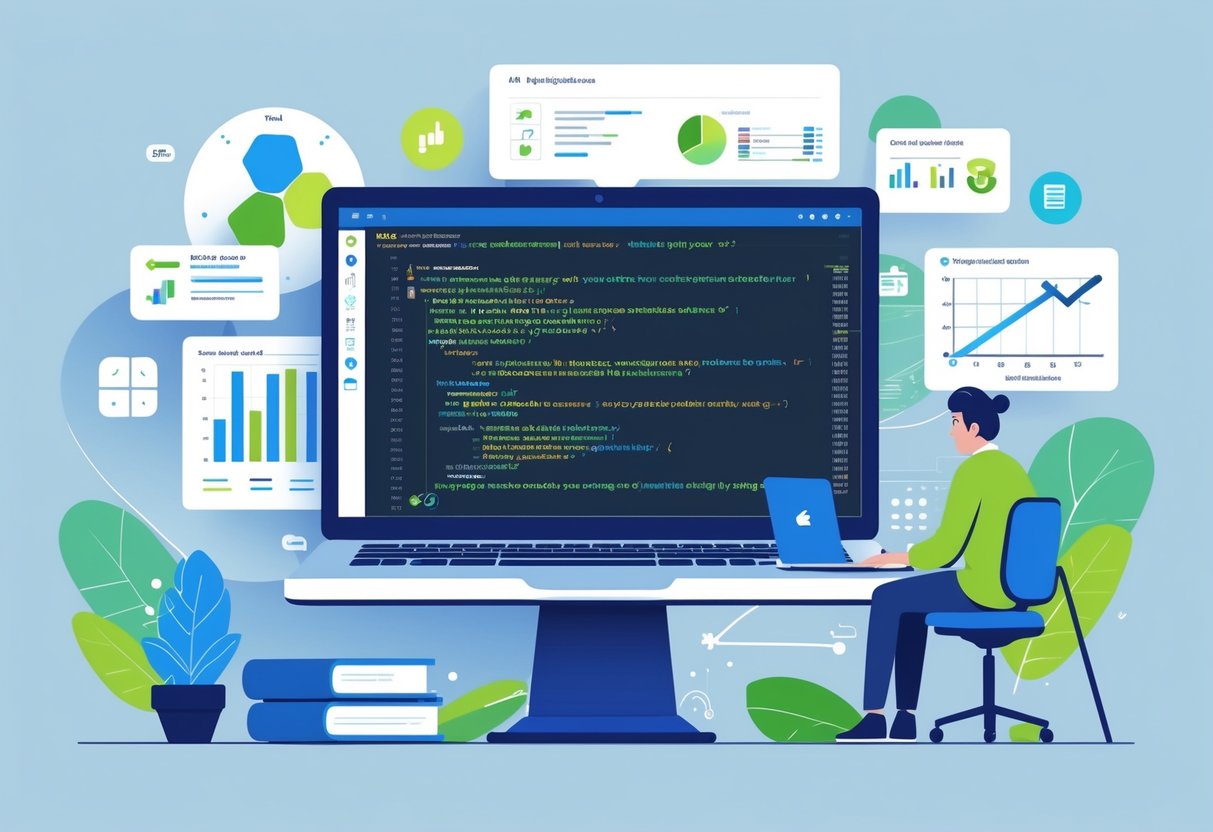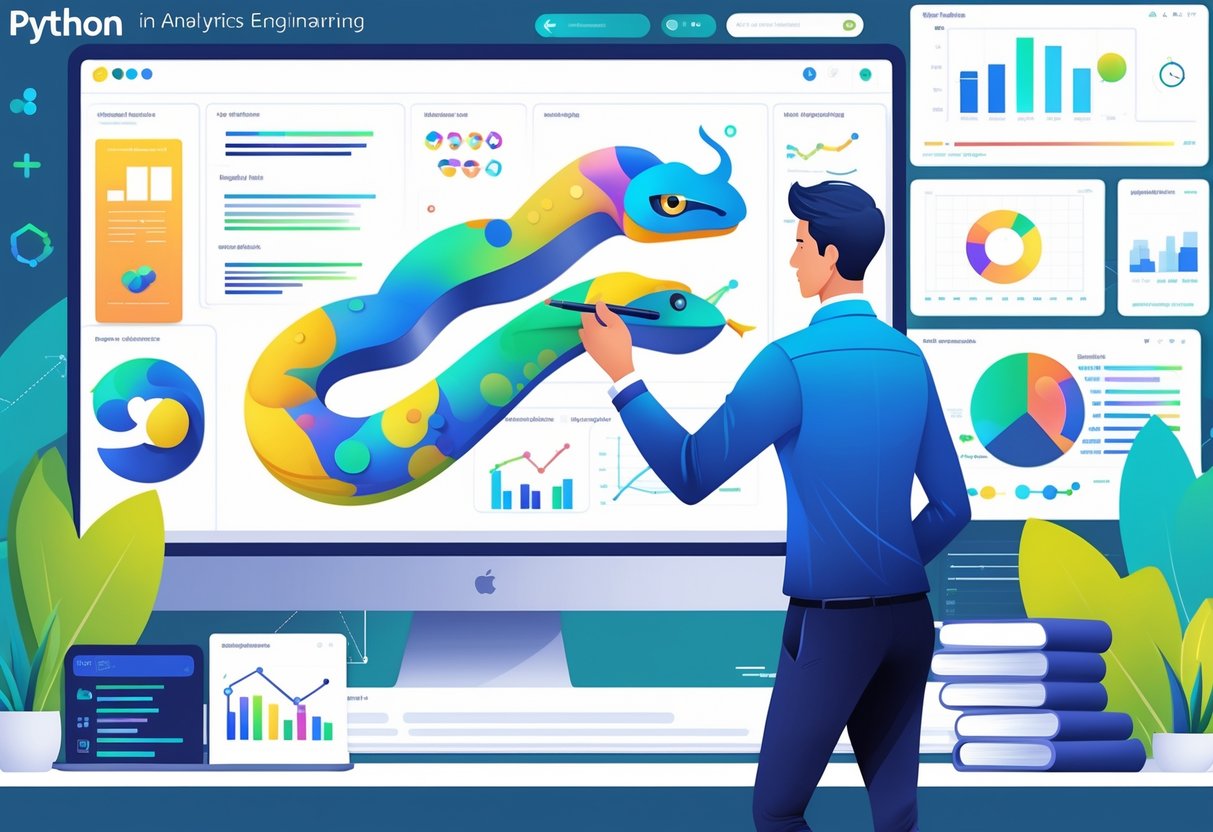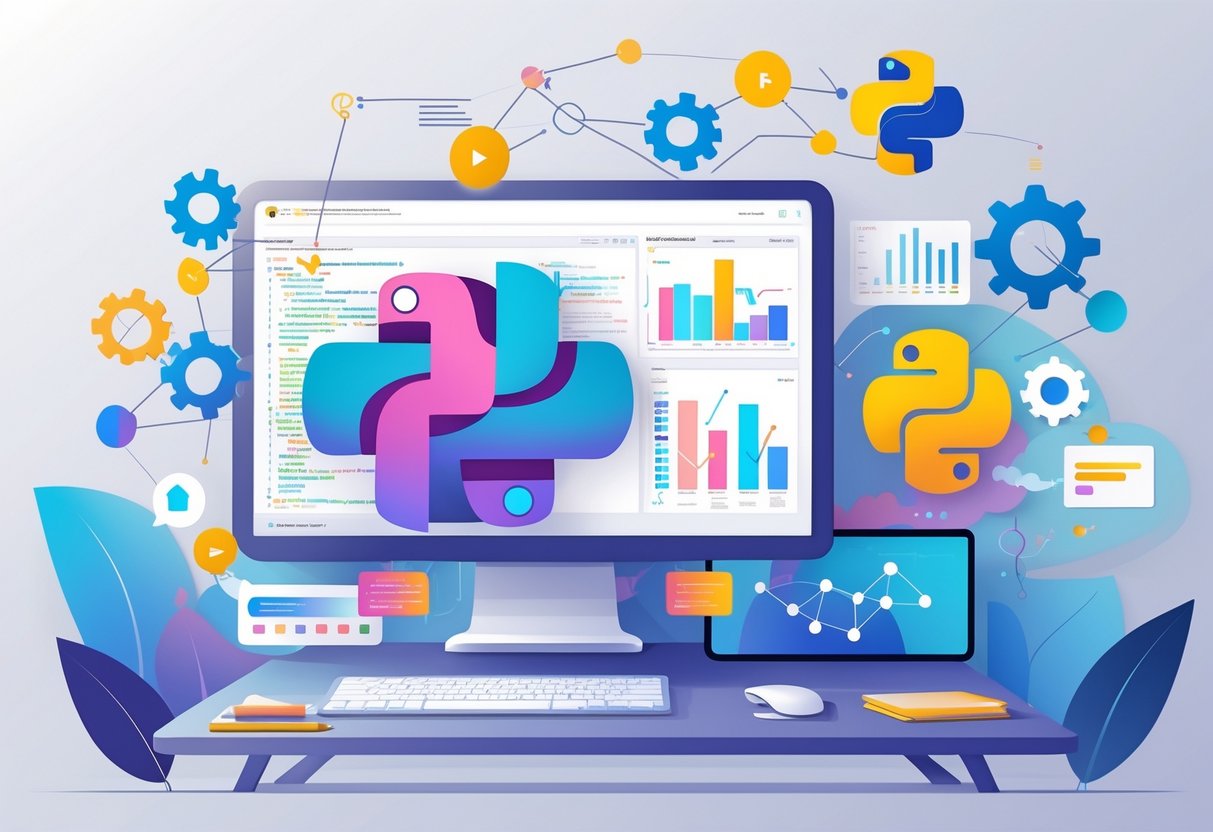Analytics engineering sits at the crossroads of data engineering and analytics, requiring professionals to transform raw data into reliable insights.
Many newcomers wonder where to begin their journey, especially when choosing the right programming language and foundational skills.

Python has become the go-to language for analytics engineering because it combines powerful data manipulation capabilities with an accessible learning curve, making it perfect for building data pipelines and performing complex analyses.
The language offers extensive libraries specifically designed for data work, from pandas for data manipulation to SQLAlchemy for database connections.
Getting started doesn’t require years of programming experience.
With the right approach to learning Python basics for data analysis, professionals can quickly build the skills needed to set up environments, work with databases, and create automated workflows that power modern analytics teams.
Key Takeaways
- Python offers the ideal balance of power and simplicity for analytics engineering workflows
- Setting up the right development environment and mastering core data concepts creates a solid foundation
- Building practical experience through real projects accelerates the transition from basics to advanced analytics engineering skills
Why Python Is Essential for Analytics Engineering

Python serves as the backbone of modern data engineering workflows, offering powerful libraries and simple syntax that streamline complex data operations.
The language provides essential tools for building scalable data pipelines, processing large datasets, and integrating with various data systems that analytics engineers encounter daily.
Python’s Role in Modern Data Engineering
Python has become the dominant language in data engineering because of its versatility and rich ecosystem.
Python stands out among programming languages for data processing tasks due to its extensive library support and community resources.
Modern data engineers use Python to build ETL pipelines that extract data from multiple sources.
The language connects seamlessly with databases, APIs, and cloud services.
Python handles both structured and unstructured data efficiently.
Key Python applications in data engineering include:
- Building automated data pipelines
- Processing streaming data in real-time
- Integrating with cloud platforms like AWS, Azure, and GCP
- Connecting to databases and data warehouses
- Creating data quality monitoring systems
Python frameworks like Apache Airflow and Prefect rely on Python for workflow orchestration.
These tools help data engineers schedule and monitor complex data processing tasks across distributed systems.
Benefits of Using Python for Analytics Workflows
Python expedites and simplifies the analysis process through its intuitive syntax and powerful data manipulation capabilities.
Analytics engineers can write readable code that other team members easily understand and maintain.
The language offers significant performance advantages for data processing tasks.
Libraries like NumPy and Pandas handle large datasets efficiently.
Python’s memory management optimizes resource usage during data transformations.
Python provides these workflow benefits:
| Benefit | Description |
|---|---|
| Rapid Development | Simple syntax reduces coding time |
| Library Ecosystem | Extensive tools for every data task |
| Scalability | Handles small scripts to enterprise systems |
| Integration | Connects with existing data infrastructure |
Python integrates with popular analytics tools and platforms.
Data engineers can combine Python scripts with SQL databases, visualization tools, and machine learning platforms.
This flexibility reduces the need to learn multiple programming languages.
Core Python Skills Needed for Data Engineers
Data engineers need specific Python proficiency to build resilient and stable data pipelines.
The foundational skills focus on data processing, system integration, and pipeline automation.
Essential Python concepts include:
- Data structures: Lists, dictionaries, and sets for organizing information
- Functions and classes: Building reusable code components
- Error handling: Managing exceptions in data processing workflows
- File operations: Reading and writing various data formats
- API interactions: Connecting to external data sources
Data engineers must master key Python libraries for analytics work.
Pandas handles data manipulation and cleaning tasks.
SQLAlchemy manages database connections and queries.
Requests library facilitates API data collection.
Advanced skills include:
- Multiprocessing for parallel data processing
- Memory optimization techniques for large datasets
- Testing frameworks for reliable pipeline code
- Version control integration with Git workflows
Python proficiency demonstrates technical competence during data engineering interviews.
Employers expect candidates to write clean, efficient Python code that scales with growing data volumes.
Setting Up Your Analytics Engineering Environment

A proper Python environment forms the foundation for effective analytics engineering work.
The right tools, libraries, and configuration will streamline data processing tasks and prevent common compatibility issues.
Choosing the Right Python Tools and IDEs
Visual Studio Code stands out as the top choice for analytics engineering projects.
It offers excellent Python support through extensions and integrates well with version control systems.
The Python extension provides syntax highlighting and debugging capabilities.
Pylance adds intelligent code completion and error detection.
The Jupyter extension enables notebook functionality directly within the editor.
Essential VS Code Extensions:
- Python (Microsoft)
- Pylance
- Jupyter
- GitLens
PyCharm Professional offers another solid option with built-in database tools and advanced debugging features.
However, VS Code’s lightweight nature and extensive customization make it ideal for most analytics workflows.
Jupyter notebooks work well for exploratory data analysis and prototyping.
They allow analysts to combine code, visualizations, and documentation in a single interface.
Command-line tools like ipython provide an enhanced interactive Python experience.
This proves valuable for quick data exploration and testing code snippets.
Installing and Managing Python Libraries
Virtual environments prevent library conflicts between different projects.
Each project gets its own isolated space with specific package versions.
Creating a virtual environment requires just a few commands:
python -m venv analytics_env
source analytics_env/bin/activate # On Windows: analytics_envScriptsactivate
Core libraries for analytics engineering include:
- pandas for data manipulation and analysis
- numpy for numerical computing operations
- sqlalchemy for database connections
- requests for API interactions
The essential Python libraries for data engineering typically include pandas, numpy, and sqlalchemy as foundational tools.
Installing packages through pip works best with a requirements.txt file.
This ensures consistent environments across different machines and team members.
Regular updates keep libraries current with security patches and new features.
However, test updates in development environments before applying them to production workflows.
Configuring Environments for Data Projects
Project structure organization prevents confusion and supports team collaboration.
A standard layout makes code easier to navigate and maintain.
Recommended project structure:
analytics_project/
├── data/ # Raw and processed data files
├── src/ # Python source code
├── notebooks/ # Jupyter notebooks
├── tests/ # Unit tests
├── requirements.txt
└── README.md
Environment variables store sensitive information like database credentials and API keys.
They keep secrets out of code repositories while allowing easy configuration changes.
A .env file can hold these variables locally.
The python-dotenv library loads them into the application environment automatically.
Configuration files in YAML or JSON format store non-sensitive settings.
These might include database connection strings, file paths, and processing parameters.
Version control integration through git tracks changes and enables collaboration.
A proper .gitignore file excludes sensitive data and temporary files from the repository.
Fundamental Python Concepts for Data Engineering

Data engineers need to master specific Python tools and concepts to build effective data pipelines.
These include core programming structures, file operations, numerical computing libraries, and database connections.
Essential Syntax and Data Structures
Python’s basic syntax forms the foundation for all data engineering tasks.
Variables store data using simple assignments like name = "John" or age = 25.
Data engineers work with four main data structures daily.
Lists hold ordered collections: numbers = [1, 2, 3, 4].
Dictionaries store key-value pairs: person = {"name": "Alice", "role": "engineer"}.
Tuples create immutable sequences: coordinates = (10, 20).
Sets contain unique values: unique_ids = {101, 102, 103}.
Control flow statements manage program logic.
For loops iterate through data: for item in data_list:.
If statements handle conditions: if value > 100:.
Functions organize reusable code blocks.
They accept parameters and return results: def clean_data(raw_data): return processed_data.
Exception handling prevents crashes during data processing.
Try-except blocks catch errors: try: process_file() except FileNotFoundError: handle_missing_file().
Reading and Writing Data with Python
Python handles multiple file formats essential for data engineering workflows.
The built-in open() function reads text files, CSV files, and JSON data.
CSV files are common in data pipelines.
Python’s csv module parses these files: import csv then csv.reader(file) for reading rows.
JSON data appears frequently in APIs and web services.
The json module converts between Python objects and JSON strings: json.loads() for parsing and json.dumps() for creating.
File operations require proper resource management.
Context managers automatically close files: with open('data.txt', 'r') as file: content = file.read().
File paths need careful handling across different systems.
The pathlib module provides cross-platform path operations: from pathlib import Path.
Data engineers often work with compressed files.
Python’s gzip and zipfile modules handle compressed data without external tools.
Error handling becomes critical when processing large datasets.
Missing files, corrupted data, and permission errors require robust exception handling strategies.
Working with pandas and numpy
NumPy provides the mathematical foundation for data engineering.
It creates efficient arrays for numerical computations: import numpy as np then arr = np.array([1, 2, 3]).
NumPy arrays perform operations much faster than Python lists.
Mathematical functions work on entire arrays: np.sum(arr), np.mean(arr), np.max(arr).
Pandas builds on NumPy to handle structured data.
DataFrames represent tables with rows and columns: import pandas as pd then df = pd.DataFrame(data).
Loading data becomes simple with pandas.
pd.read_csv() imports CSV files.
pd.read_json() handles JSON data.
pd.read_excel() processes Excel files.
Data cleaning operations are essential for analytics engineering.
Pandas handles missing values with df.dropna() or df.fillna().
Duplicate removal uses df.drop_duplicates().
| Operation | pandas Method | Purpose |
|---|---|---|
| Filter rows | df[df.column > value] | Select specific data |
| Group data | df.groupby('column') | Aggregate by categories |
| Merge tables | pd.merge(df1, df2) | Combine datasets |
Data transformation prepares information for analysis.
The Python fundamentals track covers these essential operations in detail.
Integrating SQL in Python Workflows
Python connects to databases through specialized libraries.
SQLite works with the built-in sqlite3 module for local databases.
PostgreSQL requires psycopg2.
MySQL uses mysql-connector-python.
Database connections follow a standard pattern.
Create a connection object, execute queries, and close connections properly: conn = sqlite3.connect('database.db').
SQL queries execute through Python cursor objects.
cursor.execute("SELECT * FROM table") runs queries.
cursor.fetchall() retrieves results.
Pandas simplifies database operations significantly.
pd.read_sql() executes queries and returns DataFrames directly.
This eliminates manual cursor management.
SQLAlchemy provides advanced database functionality.
It creates database engines: engine = create_engine('postgresql://user:pass@host/db').
Pandas works seamlessly with SQLAlchemy engines.
Data engineers often move data between databases and files.
Python handles ETL processes by reading from one source and writing to another destination.
Query parameterization prevents SQL injection attacks.
Always use parameterized queries: cursor.execute("SELECT * FROM table WHERE id = ?", (user_id,)).
Python for data engineering courses teach these database integration patterns through hands-on practice.
Next Steps: Building on Python Foundations

Strong Python fundamentals create the base for advanced analytics engineering skills.
Data engineers need structured learning paths, hands-on practice with real datasets, and beginner-friendly projects to develop expertise.
Learning Pathways for Analytics Engineers
Analytics engineers should focus on mastering core Python building blocks including data types, variables, and conditional logic. This foundation supports advanced data manipulation tasks.
The next priority involves learning NumPy and Pandas libraries. These tools handle most data analysis work that analytics engineers encounter daily.
Essential Learning Sequence:
Python syntax and data structures
File handling and data input/output
NumPy for numerical computing
Pandas for data manipulation
SQL integration with Python
Data engineers benefit from structured courses that build skills step by step. These programs are designed to help non-programmers gain confidence in analytics workflows.
Advanced topics include database connections, API integrations, and workflow automation. These skills enable analytics engineers to build scalable data systems.
Practicing with Real Data Sets
Real-world data presents challenges that tutorials cannot replicate. Analytics engineers need experience with messy, incomplete datasets to develop problem-solving skills.
Public datasets from government agencies, research institutions, and companies provide excellent practice opportunities. These datasets often require cleaning, validation, and transformation.
Recommended Data Sources:
Census Bureau economic data
Healthcare.gov insurance statistics
Stock market price feeds
Weather and climate records
Social media APIs
Hands-on, project-based practice helps analytics engineers master data manipulation with Pandas. Working with different file formats builds versatility.
Data engineers should practice connecting to databases, handling API responses, and processing streaming data. These scenarios mirror actual job requirements.
Recommended Projects for Beginners
Analytics engineers can start with spreadsheet automation projects. Converting Excel workflows to Python demonstrates immediate value and builds confidence.
A sales data analysis project teaches essential skills. This involves loading CSV files, calculating metrics, and creating summary reports.
Beginner Project Ideas:
Customer analysis: Segment customers by purchase patterns
Inventory tracking: Monitor stock levels and reorder points
Financial reporting: Automate monthly expense summaries
Data quality checks: Identify missing or inconsistent records
Building simple scripts for processing data in spreadsheets and databases creates practical experience. These projects teach data engineers how to automate repetitive tasks.
Web scraping projects introduce API usage and data collection techniques. Analytics engineers learn to gather data from multiple sources and combine them effectively.
Each project should include data validation, error handling, and documentation. These practices prepare analytics engineers for production data systems.
Frequently Asked Questions
Python beginners often wonder about essential concepts like data structures, pandas, and NumPy for analytics work. Most learners need 1-2 hours daily practice and can start with either Python or SQL depending on their career goals.
What are the essential Python concepts I need to learn for analytics engineering?
Analytics engineers should master Python’s core data structures first. Lists, dictionaries, and tuples form the foundation for handling data.
NumPy serves as the primary library for numerical calculations and array operations. It provides fast mathematical functions that work with large datasets.
Pandas becomes crucial for data manipulation tasks. This library allows engineers to work with structured data using DataFrames, similar to spreadsheets.
Data visualization requires matplotlib and seaborn knowledge. These tools create charts, graphs, and statistical plots for presenting findings.
Control structures like loops and conditional statements help automate repetitive tasks. Functions and modules organize code for reusable analytics workflows.
Which online platforms offer comprehensive Python tutorials for beginners in data analysis?
Dataquest provides a complete collection of Python tutorials specifically designed for data science beginners. Their guided projects offer hands-on experience with real datasets.
Interactive coding platforms let students practice immediately. These environments provide instant feedback on syntax and logic errors.
Video-based learning platforms offer visual explanations of complex concepts. Many include downloadable code examples and practice exercises.
University courses available online cover both theory and practical applications. These structured programs often include assignments and peer interaction.
How can I apply Python skills to real-world data analysis projects?
Start with small datasets from personal interests or hobbies. Analyzing spending habits, fitness data, or social media metrics provides practical experience.
Public datasets offer more complex challenges for skill development. Government databases, sports statistics, and weather data contain rich information for exploration.
Business case studies simulate workplace scenarios. Creating sales reports, customer segmentation, and performance dashboards mirrors professional tasks.
Open source projects allow collaboration with other developers. Contributing to existing analytics tools builds both technical skills and professional networks.
Portfolio projects demonstrate capabilities to potential employers. Documenting the analysis process and presenting clear findings showcases professional competence.
What is the recommended time commitment per day to become proficient in Python for analytics?
Most beginners benefit from 1-2 hours of daily practice. Consistent study produces better results than intensive weekend sessions.
The first month should focus on basic syntax and core concepts. This foundation supports more advanced analytics topics later.
Month two through four can introduce specialized libraries. Pandas, NumPy, and visualization tools require dedicated practice time.
Advanced proficiency typically develops after 6-12 months of regular use. Complex projects and professional applications accelerate this timeline.
Practice frequency matters more than session length. Thirty minutes daily outperforms three-hour weekly sessions for skill retention.
For a career in data analysis, should I focus on learning Python before SQL?
Both languages serve different but complementary purposes in data analysis. Python handles complex calculations and machine learning while SQL manages database queries.
Entry-level positions often require stronger SQL skills initially. Most companies store data in databases that require SQL for extraction.
Python becomes more valuable for advanced analytics roles. Statistical analysis, predictive modeling, and automation rely heavily on Python capabilities.
Learning both languages simultaneously works well for many students. Basic SQL queries can run alongside Python data manipulation practice.
Career goals should guide the learning sequence. Database-focused roles need SQL first, while research positions prioritize Python skills.
What are the advantages of using Python for data analysis in comparison to other programming languages?
Python offers simple, readable syntax that beginners can understand quickly. This accessibility reduces the learning curve compared to languages like Java or C++.
The extensive library ecosystem provides pre-built solutions for common tasks. Libraries such as Pandas, scikit-learn, and matplotlib eliminate the need to write complex functions from scratch.
Cross-platform compatibility ensures code runs on Windows, Mac, and Linux systems. This flexibility supports diverse team environments and deployment scenarios.
Strong community support offers abundant tutorials, documentation, and forums. Developers can find solutions to most problems through online resources.
Python is widely adopted by major companies such as Netflix, NASA, and Facebook for data-intensive applications. This widespread industry use creates job opportunities.
Integration capabilities allow Python to connect with databases, web services, and other programming languages. This versatility supports complex analytics workflows.




